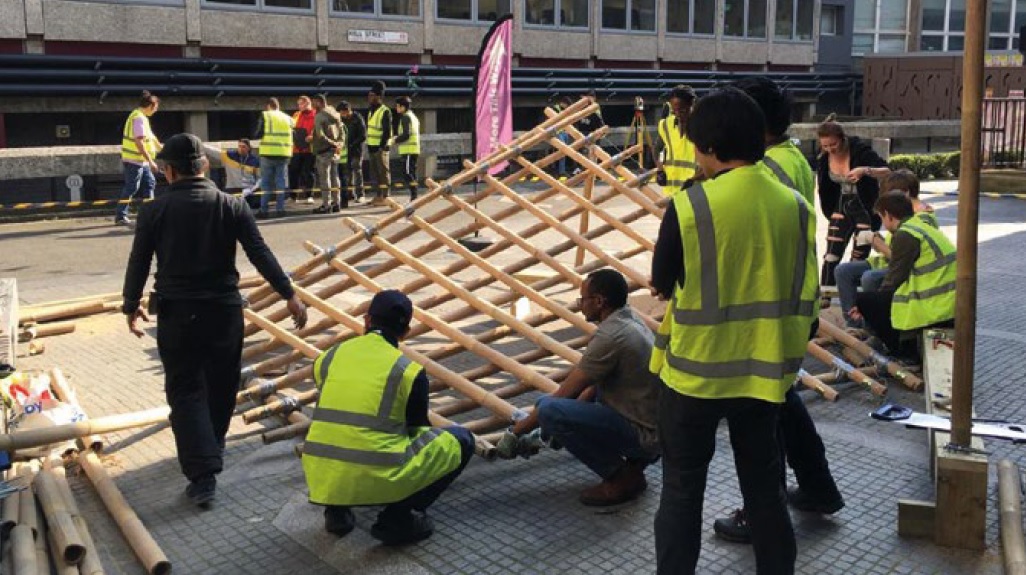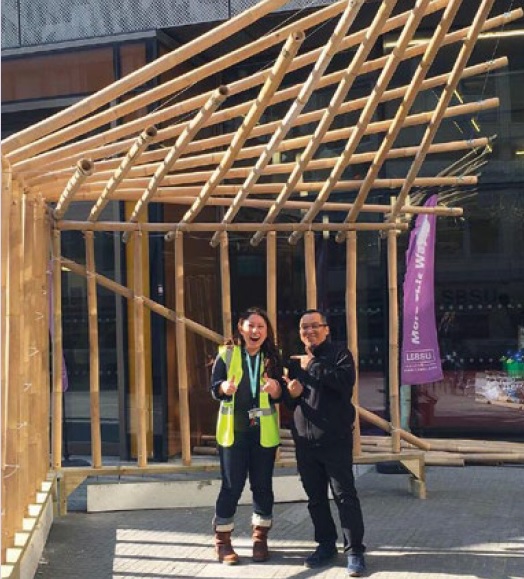Tensegrity bamboo pavilion

|
| Jennifer Hardi MCIAT, Project Leader and Programme Director at London South Bank University teamed up with bamboo architecture expert Dr Andry Widyowijatnoko and other colleagues from the Institute of Technology Bandung (ITB) Indonesia to build a temporary tensegrity bamboo pavilion. |
Contents |
[edit] Introduction
This project was a demonstration of how a sustainable material, such as bamboo, can be used to create an inspiring structure. The work is a continuation of a research-funded project through the Royal Academy of Engineering and HEFCE (now Office for Students) that Jennifer Hardi is leading. This involves multi-disciplinary collaborative working in BIM, and in designing sustainable waste recycling facilities to tackle solid waste management in a coastal tourism area in Indonesia.
The bamboo workshop was carried out at London South Bank University and, over three days, 40 students and 10 colleagues from various disciplines, ranging from architectural technology, architectural engineering, structural engineering, building surveying, civil engineering, construction management and research enterprise team, joined forces to lend a hand and provide some emotional support in building the bamboo pavilion.
With the confirmation of design received only two weeks before the D-Day for construction, clear communication and multi-disciplinary collaborative working played a crucial role in making sure the project was delivered on time.
The first challenge occurred when a decision had to be made on the most robust foundation for the temporary structure. A concrete foundation was proposed. But with such short available, plus the health and safety issues of getting the concrete to cure in that time, and transportation to the site (right next to the Student Union bar), this was not deemed to be an ideal solution.

|
The second proposal was to use a thick steel beam as the foundation for the structure but due to budget constraints this was quickly set aside. A third most feasible and sustainable solution was to re-use/re-purpose a concrete testing beam available in the engineering lab as the foundation for the bamboo structure.
Day two of the bamboo workshop saw further work done on the tensegrity roof and its supporting columns. The bamboo grid was secured in place initially with tape before the steel wires were applied onto each pole.
Day three was the biggest challenge in terms of raising the tensegrity bamboo roof onto the supporting bamboo poles. With a forklift being out of the question due to the difficulty in lifting the bamboo roof while maintaining its stability, a decision was made to rely solely on brute strength.
[edit] About Tensegrity Structure
Tensegrity is an abbreviation of tensile and integrity. It is also known as tensional integrity or floating compression, with structural principles based on the use of isolated components in compression inside a net of continuous tension. In this way, the compressed members do not touch each other and the pre-stressed tensioned members delineate the system spatially.
The picture to the right shows the tensegrity design of the bamboo pavilion by Dr Andry Widyowijatnoko that was built at London South Bank University. The core tensegrity roof was supported with bamboo columns, timber base and re-purpose concrete beam as foundation for the structure.
A tensegrity structure comprises tension and compression members where the compression members do not connect with each other. Metal wire was used in this design to act as the tension member while the bamboo poles were used as compression members. Wires were strengthened in the construction process to provide a rigid and stable structure.
[edit] Project data
Bamboo Pavilion Structure constructed in March 2019,
Designed by: Andry Widyowijatnoko, Institute of Technology, Bandung, Indonesia.
Project Leader: Jennifer Hardi, London South Bank University, UK.
[edit] About this article
This article was written by Jennifer Hardi, BSc (Hons) PGCHE MPhil SFHEA MCIAT. It previously appeared in CIAT’s AT Journal, Issue No. 130, Summer 2019 and can be accessed HERE.
More articles by CIAT on Designing Buildings can be accessed HERE.
[edit] Related articles on Designing Buildings
- Anticlastic.
- Biaxial bending.
- Buckminster Fuller.
- Geodesic dome.
- Hyperbolic paraboloid.
- Long span roof.
- Megastructure.
- Pavilion.
- Synclastic.
- Tensile strength.
- Tensile structures.
- The development of structural membranes.
- The history of fabric structures.
- Verticality.
--CIAT
Featured articles and news
UCEM becomes the University of the Built Environment
Major milestone in its 106-year history, follows recent merger with London School of Architecture (LSE).
Professional practical experience for Architects in training
The long process to transform the nature of education and professional practical experience in the Architecture profession following recent reports.
A people-first approach to retrofit
Moving away from the destructive paradigm of fabric-first.
International Electrician Day, 10 June 2025
Celebrating the role of electrical engineers from André-Marie Amperè, today and for the future.
New guide for clients launched at Houses of Parliament
'There has never been a more important time for clients to step up and ...ask the right questions'
The impact of recycled slate tiles
Innovation across the decades.
EPC changes for existing buildings
Changes and their context as the new RdSAP methodology comes into use from 15 June.
Skills England publishes Sector skills needs assessments
Priority areas relating to the built environment highlighted and described in brief.
BSRIA HVAC Market Watch - May 2025 Edition
Heat Pump Market Outlook: Policy, Performance & Refrigerant Trends for 2025–2028.
Committing to EDI in construction with CIOB
Built Environment professional bodies deepen commitment to EDI with two new signatories: CIAT and CICES.
Government Grenfell progress report at a glance
Line by line recomendation overview, with links to more details.
An engaging and lively review of his professional life.
Sustainable heating for listed buildings
A problem that needs to be approached intelligently.
50th Golden anniversary ECA Edmundson apprentice award
Deadline for entries has been extended to Friday 27 June, so don't miss out!
CIAT at the London Festival of Architecture
Designing for Everyone: Breaking Barriers in Inclusive Architecture.
Mixed reactions to apprenticeship and skills reform 2025
A 'welcome shift' for some and a 'backwards step' for others.























